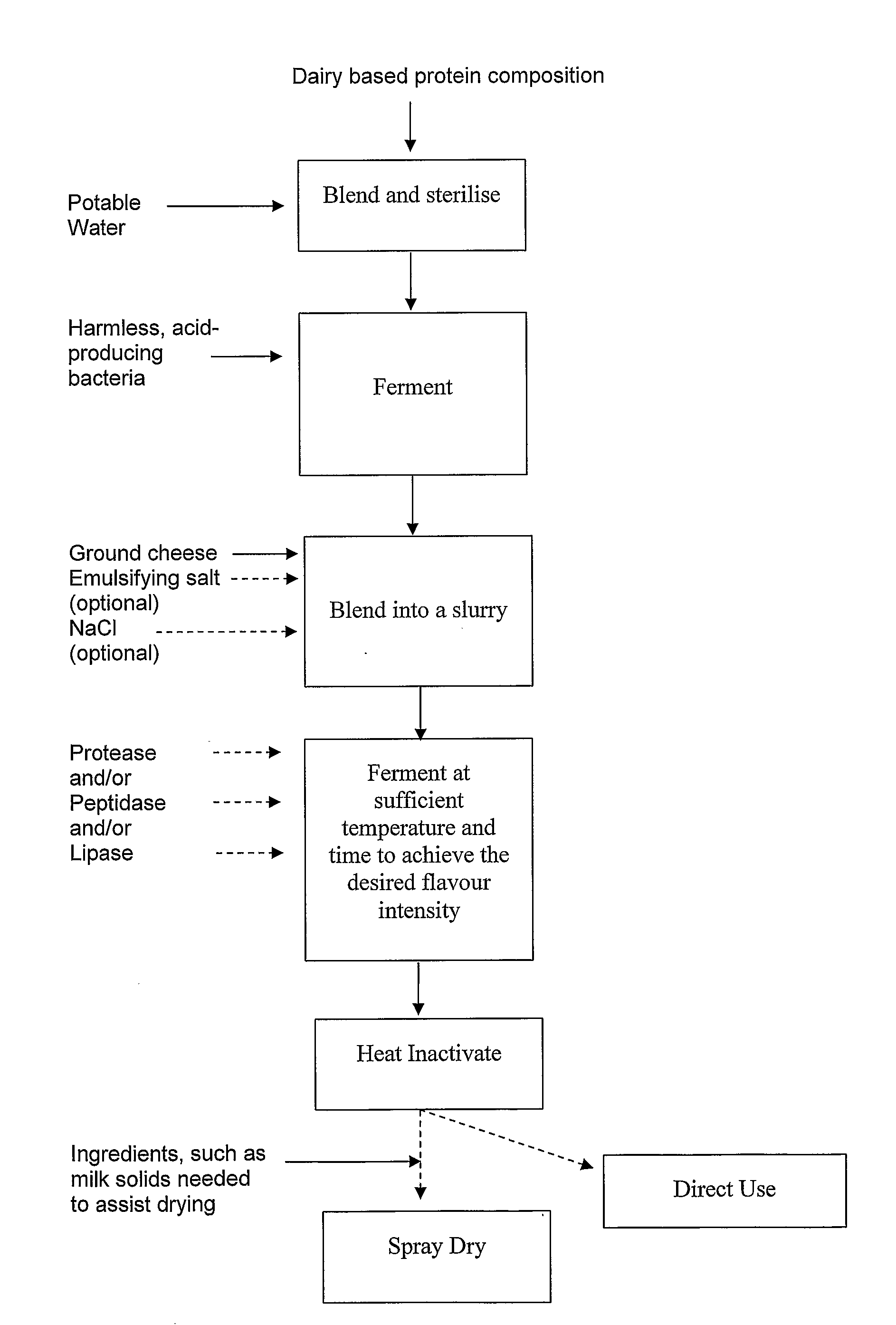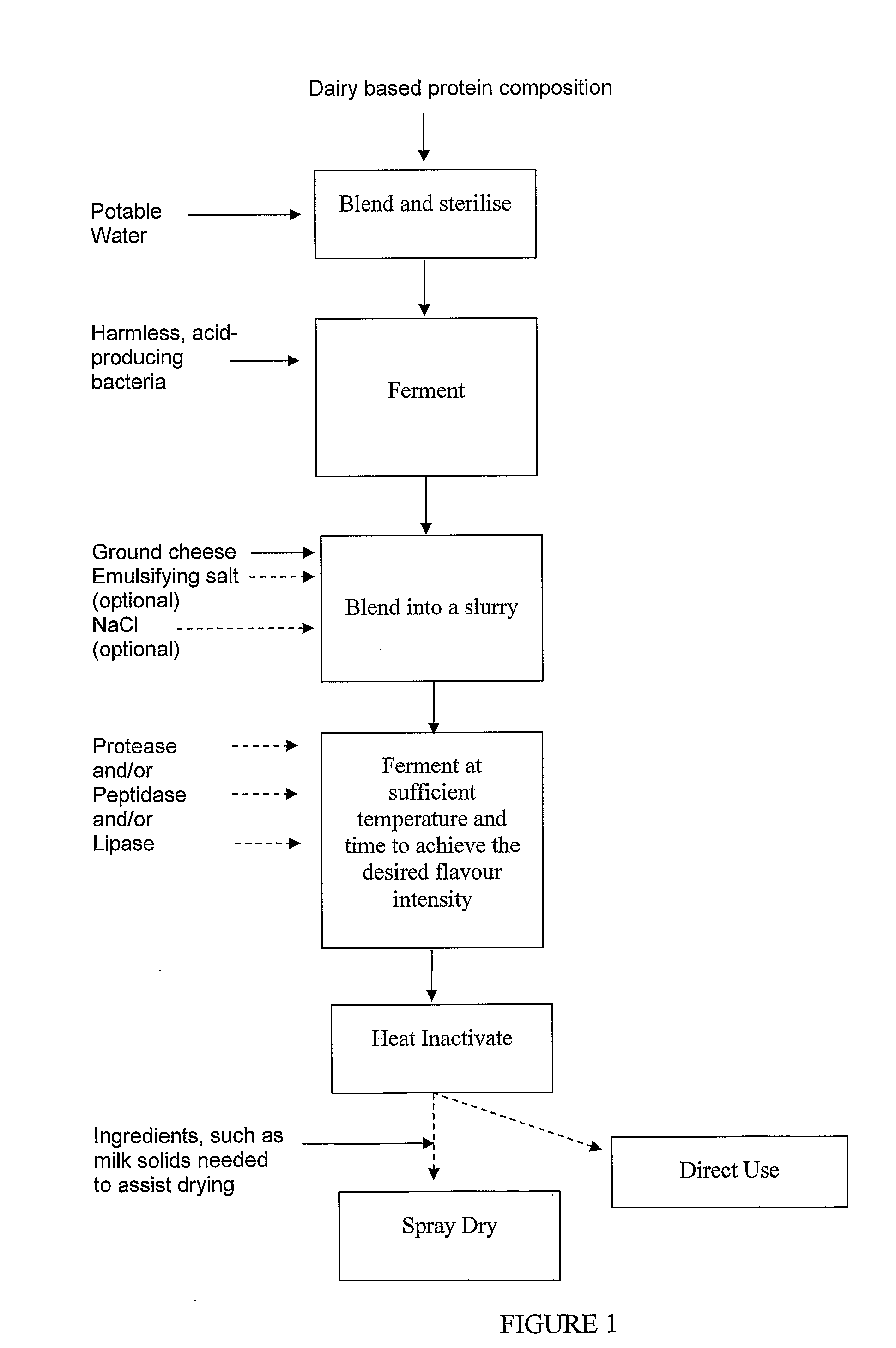Dairy Product and Process
a technology dairy products, which is applied in the field of dairy flavour ingredients, can solve the problems of lack of balanced flavour profile of emc flavour ingredients produced by these processes, lack of flavour profile of dairy products, and lack of flavour profile of emc flavour ingredients
- Summary
- Abstract
- Description
- Claims
- Application Information
AI Technical Summary
Benefits of technology
Problems solved by technology
Method used
Image
Examples
example 1
[0058]1.3 kg of SMP was added to 11.7 litres of water in a Starter Pot and the milk composition sterilised at 90-95° C. for 90 minutes. The milk composition was then cooled to 42° C. and starter culture comprising Lactobacillus helviticus added and the composition mixed and allowed to ferment for 16 hours at 42° C., until the pH level dropped to below pH 4.
[0059]2.7 kg of the acidified composition was transferred to an EMC reactor. Ground Cheddar K Cheese (3.21 kg) and Granular K Cheese (3.21 kg) were then added to the acidified composition and the mixture gently agitated. The temperature was maintained at 42-43° C.
[0060]0.4 kg of water was used to dissolve 0.02 kg Savorase RST 100 (Rhodia), 0.0043 kg Neutrase (Novo), 0.0057 kg Protease 2A (Amano) and 0.007 kg Flavorpro 192 (Biocatalysts) before the enzyme mixture was added to the EMC reactor together with 0.115 kg of salt (NaCl). A further 0.5 kg of acidified composition was used to rinse the enzyme container and added to the react...
example 2
[0066]1.3 kg of SMP was added to 11.7 litres of water in a Starter Pot and the milk composition sterilised at 90-95° C. for 90 minutes. The milk composition was then cooled to 42° C. and starter culture comprising Lactobacillus helviticus added and the composition mixed and allowed to ferment for 16 hours at 42° C., until the pH level dropped to below pH 4.
[0067]2.7 kg of the acidified composition was added to an EMC reactor. Granular K Cheese (6.55 kg) was then added to the acidic composition and the mixture gently agitated. The temperature was maintained at 42-43° C.
[0068]0.4 kg of water was used to dissolve 0.0036 kg Neutrase (Novo), 0.0048 kg Protease 2A (Amano) and 0.0053 kg Flavorpro 192 (Biocatalysts) before the enzyme mixture was added to the reactor together with 0.115 kg salt (NaCl). A further 0.5 kg of acidified composition was used to rinse the enzyme container and added to the reactor.
[0069]The mixture in the reactor was agitated to produce a smooth slurry and agitation...
example 3
[0074]3.9 kg of wholemilk powder (WMP) was added to 9.1 kg of water in a Starter Pot and the milk composition sterilised at 90-95° C. for 90 minutes. The milk composition was then cooled to 42° C. and starter culture comprising Lactococcus lactis subsp. lactis biovar. diacetylactis added and the milk composition mixed and allowed to ferment for ˜40 hours at 42° C., until the pH level dropped to 5.1.
[0075]1.3 kg of buttermilk powder (BMP) was added to 11.7 litres of water in a Starter Pot and the buttermilk composition sterilised at 90-95° C. for 90 minutes. The buttermilk composition was then cooled to 42° C. and starter culture comprising Lactobacillus helviticus added and the buttermilk composition mixed and allowed to ferment for 16 hours at 42° C., until the pH level dropped to 3.4.
[0076]1.28 kg of the acidified buttermilk composition was blended with 1.92 kg of the acidified milk composition.
[0077]2.7 kg of the blended acidified composition was added to an EMC reactor. 4.23 kg ...
PUM
 Login to View More
Login to View More Abstract
Description
Claims
Application Information
 Login to View More
Login to View More - R&D
- Intellectual Property
- Life Sciences
- Materials
- Tech Scout
- Unparalleled Data Quality
- Higher Quality Content
- 60% Fewer Hallucinations
Browse by: Latest US Patents, China's latest patents, Technical Efficacy Thesaurus, Application Domain, Technology Topic, Popular Technical Reports.
© 2025 PatSnap. All rights reserved.Legal|Privacy policy|Modern Slavery Act Transparency Statement|Sitemap|About US| Contact US: help@patsnap.com


